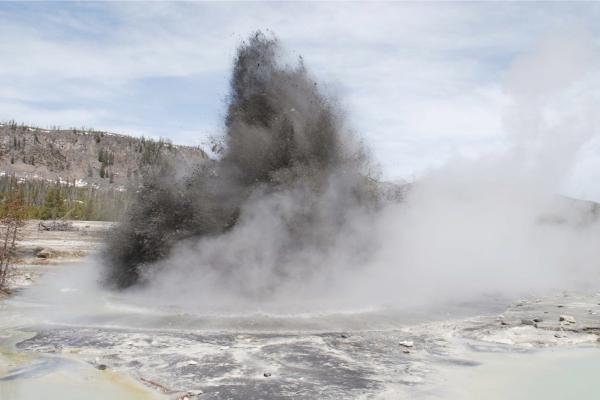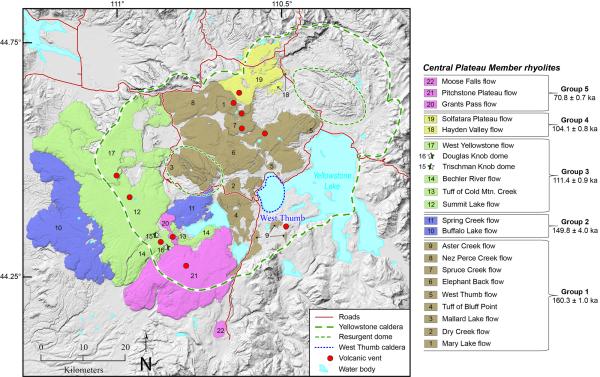Editor's note: Yellowstone Caldera Chronicles is a weekly column written by scientists and collaborators of the Yellowstone Volcano Observatory. This week's contribution is from Dan Dzurisin, emeritus geologist with the U.S. Geological Survey.
Few would argue against Yellowstone National Park being "super"—both a splendid natural wonder worthy of careful stewardship, and a super-sized volcanic system capable of correspondingly large eruptions with potentially far-reaching impacts. As the latter, it has inspired any number of disaster shows and movies, not unlike menacing asteroids, planet-rending earthquakes, and rampaging superstorms. We often hear from such movies and documentaries that Yellowstone is a "ticking time bomb" that is "overdue" for an eruption that will cause "the end of civilization."
Good with popcorn? Maybe. But let’s parse the supposed story and touch base with the facts.
Yellowstone is not a ticking time bomb, and its next eruption is not overdue. That’s because most volcanoes do not follow predictable schedules. They are exceedingly complex natural systems and their activity, including eruptions, tends to be more sporadic than regular. The "overdue" label that gets applied to Yellowstone stems from a misunderstanding of data and statistics. Yellowstone’s three large caldera-forming eruptions occurred 2.08, 1.3, and 0.631 million years ago. That’s an average of 0.725 million years (725,000 years) between eruptions, and the most recent one occurred 0.631 million years (631,000 years) ago. So the next one isn’t "due" for another 94,000 years, right?

Hydrothermal explosion at Biscuit Basin in Yellowstone National Park. These types of events are the most likely explosive hazard from the Yellowstone Volcano.
Wrong, for at least two reasons. First, as mentioned above, volcanoes don’t operate on fixed schedules. If they were buses or trains, passengers would be upset. Second, statistics based on so few data points—just three eruptions—are almost meaningless. So, neither volcanoes nor statistics work that way. There might or might not be another caldera-forming eruption in Yellowstone’s future, but there’s no basis in fact to say it’s overdue. Like most of the future, it’s just unknown.
Furthermore, Yellowstone’s next eruption won’t "trigger the end of civilization as we know it." There are two reasons for that. First, smaller and less explosive eruptions are much more common than catastrophic ones at Yellowstone. Since the eruption that formed Yellowstone caldera, there have been dozens of smaller eruptions that produced rhyolite lava flows. Granted, those eruptions were not trifling. Some of the lava flows reach as far as 30 km (19 mi) from their source vents and are more than 400 m (1,300 ft) thick. Similar events in the future would cause major disruptions to everyday life in the area, but research shows there would be adequate warning to help mitigate the effects. And second, no explosive eruptions have ever caused planet-wide extinctions. Flood basalt eruptions, which emit copious amounts of lava and gas and last for tens to hundreds of thousands of years (like the Deccan Traps in India), do have that potential, but explosive eruptions don’t last long enough to have such an impact.
In fact, the most likely and impactful hazards on human timescales at Yellowstone—hydrothermal explosions and large earthquakes—don’t even involve magma reaching the surface. Hydrothermal explosions occur every few years or so at Yellowstone. Most are small and affect areas tens of feet in diameter, like the 1989 explosion of Porkchop Geyser in Norris Geyser Basin. Less frequent, larger events could eject rocks and hot water a few thousand feet into the air—serious and very hazardous to anyone in the vicinity, but not Armageddon.

Map of Yellowstone caldera showing the locations and ages of the most recent rhyolite eruptions at Yellowstone, the Central Plateau Member rhyolites. Unit boundaries are from Christiansen (2001). The West Thumb region of Yellowstone Lake is indicated because it is thought to be the location of an explosive eruption and the source vent for the Tuff of Bluff Point. The Central Plateau Member rhyolites are broken into five informal groups based on new 40Ar/39Ar eruption ages. Each informal eruption group is shown in the same color. Numbers on the map and legend are included to indicate the location of different lava flows. Group mean ages and their 95% confidence intervals are included next to the list of units.
Earthquakes in the magnitude 6–7 range occur in the Yellowstone region about once or twice per century and pose a much greater near-term threat than a magmatic eruption. Examples include the 1959 M7.3 Hebgen Lake and 1975 M6 Yellowstone Park earthquakes. Future large earthquakes will be damaging, and their impacts felt throughout the region, but they will not be planet-wide catastrophes.
One last point: documentaries and movies will often claim that recent earthquake swarms and other activity are an indication of an impending eruption. Not so. Yellowstone typically experiences 1,500–2,500 small earthquakes annually along with hydrothermal activity, ground deformation (both up and down), and other volcanic vital signs. But those are background signs of repose in the hydrothermally active area that is Yellowstone, and not short-term indicators of a future eruption.
Critic’s summary: Enjoy disaster movies if you’re so inclined. But keep in mind that as a purveyor of impending planetary doom, Yellowstone is clearly overrated. In almost every other respect, it’s just "super."




 Support Essential Coverage of Essential Places
Support Essential Coverage of Essential Places







Add comment